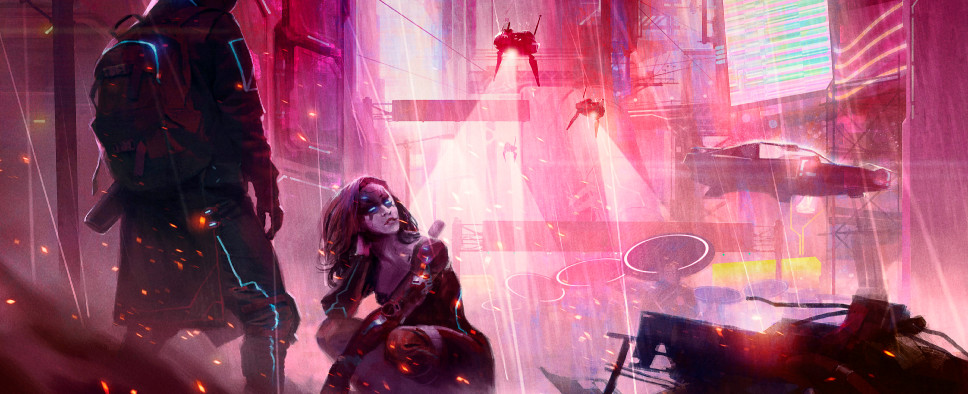Conglomerate 451 Review - Page 2
-
Category: ReviewsHits: 10723

Article Index
Now, there’s no shame in a dungeon crawler having a basic combat system, but when that’s the case, we usually have to deal with some long-term strategic resource management instead. Conglomerate 451 tries to implement something like this by giving you an energy bar that you spend on hacking actions and to recharge your shields, but seeing how hacking is rarely needed and there are classes that can recharge shields for free, this doesn’t really mean much. The game also features long-term injuries and mental ailments, but once again, those can be easily circumvented by killing all your enemies before they can start really damaging your party.
Upon completing a certain number of missions, your clones level up, which improves their stats and lets you choose some perks that, just like many other things in this game, are fairly inconsequential. And seeing how most levels offer you the same three options over and over again, it’s easy to start wondering why the perk system even exists in the game.
In fact, the weirdest thing about Conglomerate 451 is how it has so many elements of a great game that just aren’t executed too well. The developers clearly have their hearts in the right place and they’re technically competent, but when it comes to systems, it’s like there was zero consideration for how they all worked and fit together.
So, let’s break down what Conglomerate 451 has to offer. It has multiple research trees, but they merely unlock new tiers of skills and items in a linear fashion. There’s plenty of loot, but all of it offers minor improvements for your pre-set gear. The game has numerous unique-looking enemies with their own strengths and weaknesses, but you’re never in a situation where you have to adjust your strategy depending on who you’re fighting. The leveling system exists, but offers negligible upgrades. There are plenty of physical and mental ailments but it’s very easy to never get afflicted in the first place. You can target different body parts in combat, but the bonuses you get for that are so minor, that aimed shots are generally not worth the lowered hit chance.
In the end, I guess I wish RuneHeads focused more on the drawing board stage of development. Played a bunch of other dungeon crawlers and roguelikes to see what worked there. Memorized Snow Crash and Neuromancer by heart. Brainstormed systems until smoke came out of their ears.
Had they done that, considering Conglomerate 451’s solid foundation, it could have ended up great. As it stands, the game is merely alright. It’s not particularly bad, but it could have easily been so much better.
Technical Information
The game was clearly created on a tight budget and so you shouldn’t expect it to have cutting edge visuals, but it still manages to look pretty decent. Enemies all have unique designs, the tilesets are varied and distinct, and everything you see pretty much screams cyberpunk.
The soundtrack is also quite fitting. It’s not exactly in the Deus Ex or Frozen Synapse ballpark, but it gets the job done. On the other hand, sound effects are weak and entirely forgettable. The game also features some limited voice acting, mostly coming from a drone that follows your squad around, and the only good thing I have to say about that drone and its voice acting, is that there’s a separate audio slider in the options menu that lets you mute it.
Speaking of options, the game has one that allows you to skip combat animations and another one that turns off head bobbing. Both of these are always good to have in my book.
During my playthrough the game mostly ran well and I didn’t encounter any crashes or major bugs. There was a particular set of levels where my framerate drastically dropped for no good reason, and from time to time enemies got stuck for a few seconds while trying to move, but other than that I didn’t notice anything broken or out of place.
The game was created by an Italian team and unfortunately the English version is far from perfect, especially when it comes to some of the skill descriptions. You can still understand it all, it just sounds a bit unnatural.
Seeing how Conglomerate 451 fancies itself as a bit of a roguelike, your progress only gets saved between missions and when you quit the game. And while not ideal, seeing how missions generally take somewhere between 10-30 minutes to complete, it’s not a particularly huge deal.
Conclusion
When all is said and done, Conglomerate 451 is a peculiar game where good ideas are counterbalanced by questionable execution. As a result, it’s very hard to love this game, but it’s even harder to outright hate it. It’s playable, competent, and can even be fun in short bursts.
So, even despite some rough edges and baffling design decisions, Conglomerate 451’s bite-sized mission structure lends itself fairly well to booting the game up, playing a mission or two and calling it a day. And seeing how we’re not spoiled for choice when it comes to dungeon crawlers these days, sometimes that’s all you can ask for.

